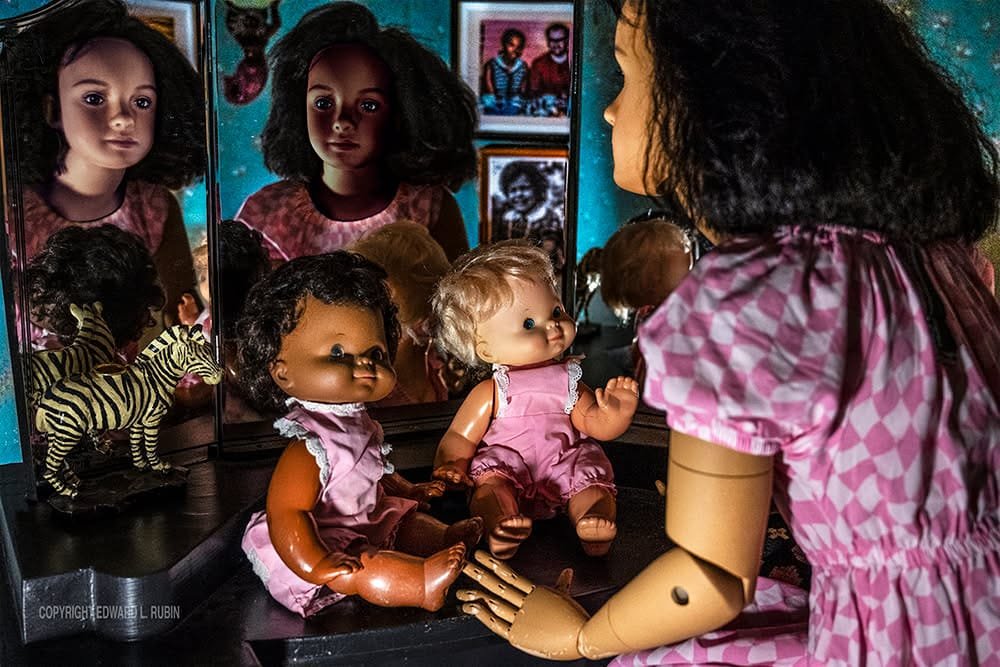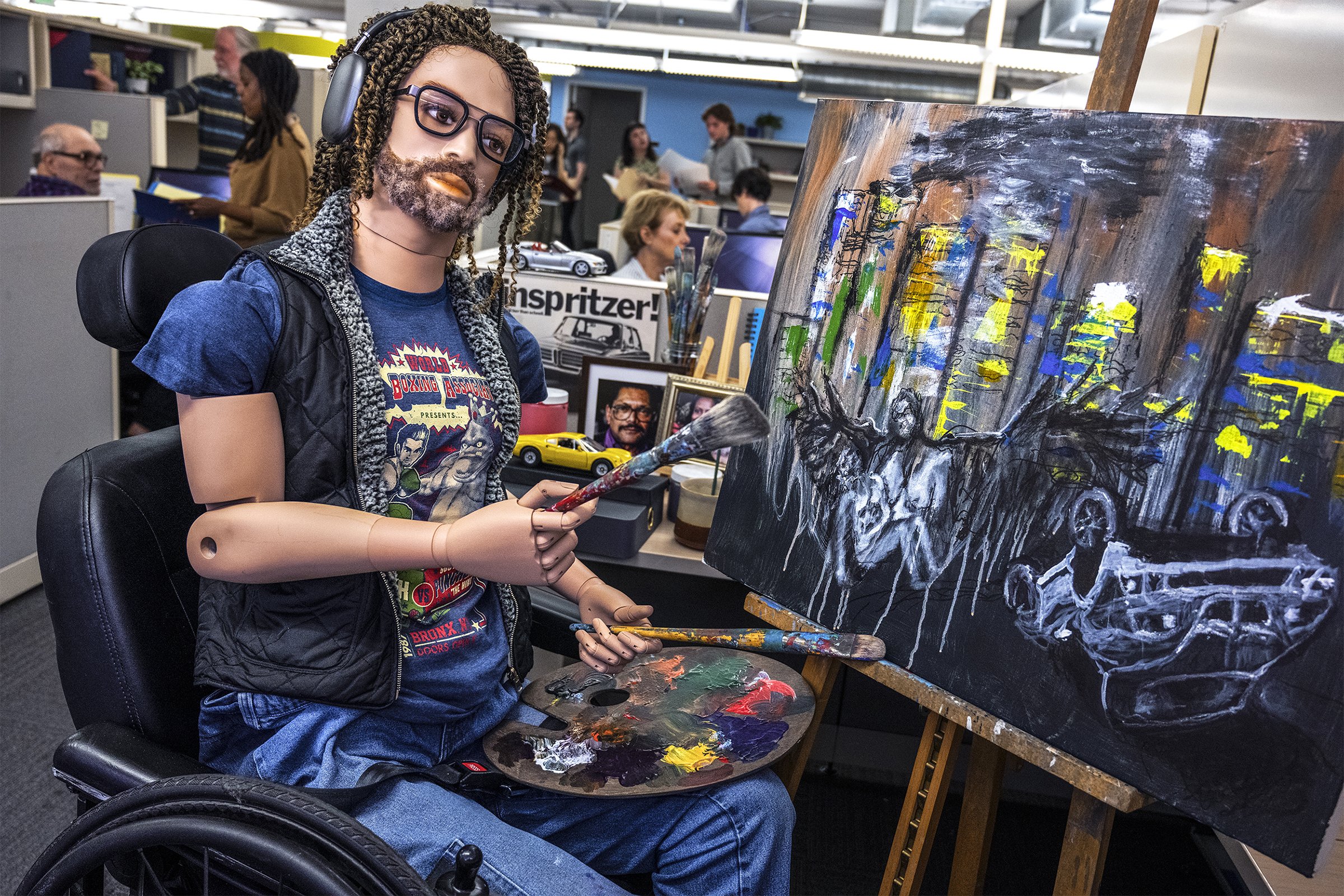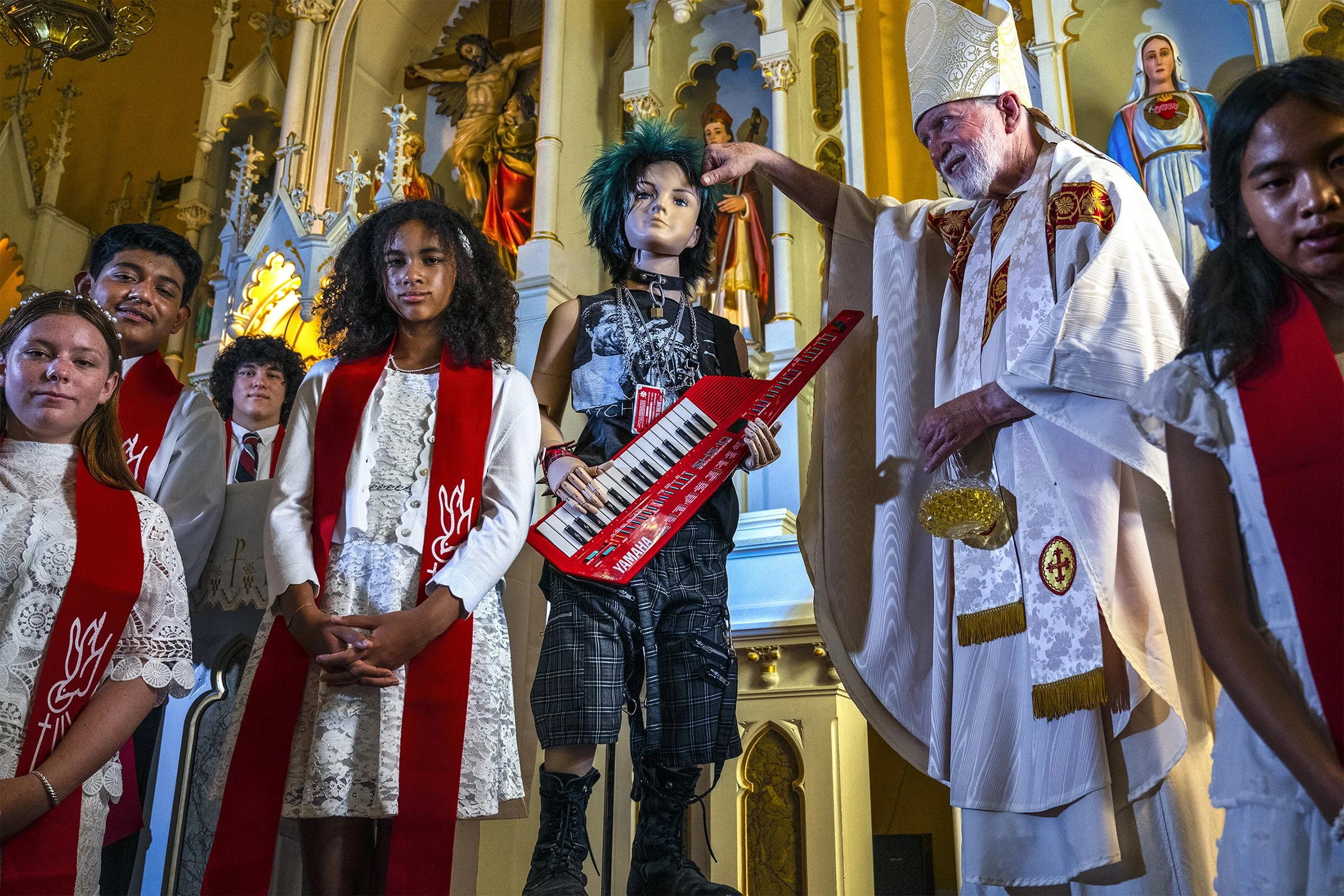I have always been a storyteller. And the world is full of stories. It has been my passion to tell these stories, first through painting, then through sets and environments I designed in film and television, and now through photography.
Why photography? Because one photograph can contain a world. One photograph can tell us everything we need to know about someone, in a particular moment, time, and place. One photograph can be an escape, or a safe haven, or a terrible reminder. That’s what it’s always been for me. Now, using the visual narrative of feature films, I selectively reveal some universal truth filtered through my personal, emotional lens. The shot is instant, it is timely, and it provides the perfect fusion of idea and creator in a single frame.
The narrative portraits that I create in the MY MANNEQUIN MOMENT series depict that transcendent moment when we know—really, really know—that we are not meant to be where we are, or be doing what we are doing, or that whatever it is we are involved with, or think, is either not for our highest good nor in our best interest; that it does not reflect our authentic selves.
How many of us have had a moment, or moments, like these? Everyone. All of us have accepted ideas, or played roles, or have been in situations and relationships that were not really what we wanted, or were not what we thought we wanted. We are born into belief systems that carve grooves in our heads about success, normalcy, power, sex, inferiority, superiority, race, class, masculinity, femininity, and beauty.
At what point do we stop listening to the voices placed in our head, and start listening to that one true Voice within us—our sacred Self? That’s the “Mannequin Moment.”
And why mannequins? Because they are abstracted idealizations of human beings that represent unattainable perfection. They are false dreams personified—literally. So, I use these artificial simulacra as surrogates for my subjects in their decisive moment when they no longer fit in; when the veil is lifted.
My hope and desire, in creating these portraits, is that the viewer recognizes themselves in them, sees and feels their own struggles, knowing they are not alone. And, in this knowing, they are empowered to step into their own greater and beautiful, authentic unfolding.

MMM AM I BLACK OR WHITE: Nya had a white Jewish communist father, and a black activist communist mother. When she turned six years old, her black aunt wanted to get her a doll for her birthday. The aunt asked if she wanted a black or white doll. Nya couldn’t choose. “You have to decide what you are,” said her aunt. People have asked her what she is her entire life.

MMM BIG GAME DAY: "When I was a kid, boys were supposed to like and excel at sports. It meant you were part of the gang, you fit in, and – most importantly – you were masculine. I hated sports. I liked drawing, painting, dancing, music, and theatre. And I really liked girl dolls, with their silky hair and beautiful clothes. I hid my secret from everyone, believing in my heart that I was a total failure – not just as a boy, but as a person."

MMM CHRISTMAS EVE 1958: One Christmas Eve, Kathryn’s father severely hurt himself in an accident with the Christmas tree and, in a furious rage, got an axe and chopped up a couch ottoman in front of the family. Little Kathryn pleaded with her mother to stop him, but she did nothing, assuring Kathryn that praying to God would handle everything. This was the default family dynamic. Artists note: I substituted the tree for the ottoman.

MMM DEFIANCE: She lived in Okinawa and dreamed of being a hip-hop artist and living in the United States, but her well off, traditional Japanese family would not allow it. To keep her in line, her mother dragged her in front of the family shrine and made her kneel before it, telling her she was a disgrace. She became a pop star in Japan anyway – and now she lives in Los Angeles, and is a Christian.

MMM HAPPY BIRTHDAY: She was married to a Silicon Valley tech geek. They had a big house, expensive cars, and a wonderful kid. She hosted sports team and birthday parties. Her husband seemed like a family man, but he had a secret life: sex addiction, cheating, strip clubs, lies, and a compulsion to view sexually explicit material. She had no idea – until their child found thousands of images on dad’s laptop. Life for everyone changed after that moment.

MMM MEMORIAL: Michael had a long career as a film and television visual effects editor, winning two Emmy Awards. His father, Adam, also worked in the entertainment industry as a carpenter building sets, but he died young. Michael couldn’t share his success with his dad – the most important person in his life. This great sadness remains an unfillable void in his heart.

MMM FIRE: John and Wendy were married in 1992 and lived in their Altadena, California home for eight years. He is a professional drummer and she is a ceramicist. On January 8, 2025, their house – and their entire neighborhood – burned down in the Eaton Fire. Seventeen people died. “We had no notice to leave but we saw that the fire was close and the winds were crazy and thought it best to go. We each left with one cat in a carrier and one rolling bag. John lost all of his musical and recording equipment plus his father’s trumpet, a 1952 D28 Martin guitar, and custom-made drums for the show Hamilton. I lost my ceramic sculptures, a gold threaded Persian prayer rug that was a gift from my mother, a large framed mosaic of a lion from my father, and china that my grandmother brought from Germany when they escaped World War II.” Wendy wanted the mannequins to be naked because that is how she felt: shattered, exposed, vulnerable, and restarting from zero.

MMM - RESURRECTION: Richard Bell was a very successful IT systems analyst and trouble-shooter working in high-end corporate offices. He modernized computer systems and revamped security protocols. At the same time his uncle, Raymond Howell –a well-known California Bay Area painter– was mentoring him as an artist, teaching him how to stretch canvases, how to use color, and apply paint. Richard also loved fast cars – they were his passion. One evening after work in 2002, while swiftly accelerating on a Los Angeles freeway transition road in his silver BMW Z3 Roadster, he hit a wet spot and the car skidded out of control, jumping the road and flipping over, then slamming into a truck which landed his car upright. Richard was gravely injured; he actually died and was brought back to life several times. He says an Angel, or some kind of Being, kept saving him despite his wanting to remain dead – it felt that good to him. But the Angel had other plans. Richard lived, and is now in a motorized wheelchair, able to move only his head and hands. He became a full-time painter, focusing his mental and physical energy creating astonishing images of jazz musicians and female nudes. He has exhibited in Beverly Hills and Los Angeles, and his work is found in galleries and private residences internationally. “I challenge the viewer to perceive a somewhat ordinary subject matter in a re-imagined way that impacts them emotionally. One’s life experience should play a role in their interpretation of my work.” Richard painted the image of his car crash and the life-saving Angel for this photograph. The car accident destroyed his old life, and created a new one.

MMM CONFIRMATION: Chad grew up in Latrobe, Pennsylvania, where his family went to church every Sunday and he was an altar boy. From six years old to his early teens, he studied music with his mother, who had been trained to be a concert pianist. Chad became a keyboard artist, first playing classical music, then gravitating to rock and roll, especially punk rock; he toured the country three times with different bands, playing nightclubs and arena shows. At his Catholic Confirmation ceremony, Chad had a realization: he was being railroaded into a belief system that wasn’t really his. No one had asked him if he wanted this, or even how he felt about it; it was an obligation. “We just had to do the thing.” The seed of individualization was planted, and through his musicianship, it grew and flowered. “Nobody chose punk rock for me, I chose it. It was cool, exciting, rebellious – and I could be myself, expressing fully who I am doing my own thing yet also being part of a community that was social and political. I found my power.” Chad also practices Ninpo Taijutsu, a form of martial arts he has trained in for forty years. He describes his dojo as “a community of brothers and sisters helping and growing together.” Like punk rock, “martial arts is about optimizing the personal self, making the most out of you as an individual so you can make the most out of what is thrown at you. So, a punk rocker who is studying martial arts is making the best of both worlds.” Chad has spent a lifetime harnessing and expressing his independent, creative potential through rigorous and disciplined self-actualization - a journey that began with his questions, in that church, so many years ago.
Morals of the Story: The Human Conditions of Edward L. Rubin
By Peter Frank
Does an artist have a moral responsibility to their audience?
And does the audience owe something in return? If an artwork tells a story visually—as has been tradition throughout Western history—who ensures the viewer grasps that story? Is there even a "correct" way to understand it?
We are inundated with messages, especially visual ones, presumed to be universally effective. But where does visual discourse end and propaganda begin? Does it depend on the storyteller, the story, or the medium?
Let’s assume that the clarity of a narrative depends on all of these. If understanding an artwork requires effort from the artist, the audience, and the context, then the responsibility ultimately falls on the artist. After all, it’s the artist’s vision that initiates this circle of comprehension. Authorship is a responsibility—not necessarily to know the audience, but to respect them.
Photography’s Moral Weight
Photography is perhaps the most morally loaded visual medium. As a machine-driven record of reality, it carries the burden of truth. When it lies, the photographer must "admit" it—much like a magician revealing a trick. Edward L. Rubin, with his background in painting and film production design, has long been fabricating realities. Yet, his photographs reveal a genuine desire to be swept away by the very fictions he creates.
Rather than manipulate, Rubin invites the viewer to share in the awe. He embraces both the lens and the pixel, not as ends in themselves, but as tools to tell compelling stories.
Pictures with Purpose
For Rubin, aesthetics are never enough. The image must also be alluring in effect. His photographs, particularly in his Mannequin Moments series, are modern fables—visually rich tales that speak directly to our innate craving for story, even amidst the static of contemporary life.
His scenes, though rooted in the everyday, feel dreamlike. They don’t just depict the mundane; they transform it. What may look like a child’s birthday party is suddenly cast in eerie ambiguity. A cemetery plot becomes an unexpected admonition. His surrealism is purposeful—not concerned with tricking the eye, but with revealing the cracks in our perception.
Rubin is no illusionist. He’s a storyteller with magical skills, not a magician dabbling in narrative. His imagination shapes every element, with digital tools and visual instincts working hand-in-hand.
Beyond Photography
Rubin’s work in drawing and other traditional forms shows the same meticulous artistry. Whether it’s metallic still lifes, layered New York street scenes, or intimate mannequin portraits, his images never rest—they vibrate with conceptual energy.
He composes with an eye for abstraction and structure, giving his subjects—no matter how fabricated—a pulse. There is nothing passive about his pictures. They are alive with suggestion and cinematic urgency.
The Cinematic Eye
Edward L. Rubin tells stories like a director, cinematographer, and puppeteer all in one. Through the lens, he channels the spirit of cinema into still photography. His images may not move, but they are far from still. With each detail, Rubin builds narrative tension and emotional resonance.
Every picture tells a story—but Rubin’s tell theirs with uncommon vigor, stunning beauty, and an unmistakable voice.
Los Angeles, August 2024